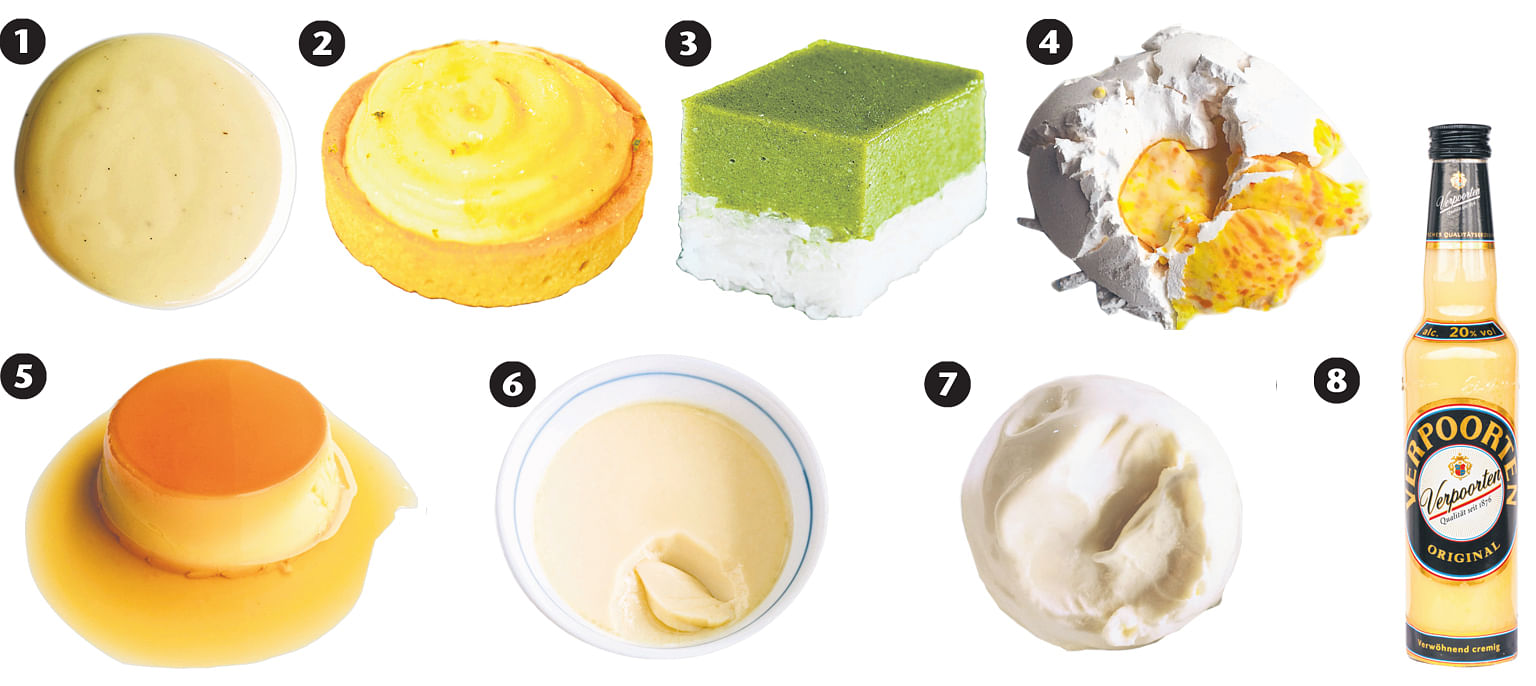Custards are no less special for being popular and ubiquitous. Here is a field guide.
• Definition: A mix of milk and/or cream, egg and sugar or seasoning cooked over steady heat until it thickens. Custard-like dishes date back to the Roman era. Most often sweet, custards may also be savoury, made with just yolks or whites instead of whole eggs, or made with non-dairy milk.
• Stirred custards: Classic English custard is slowly thickened by constant stirring in a double boiler. Shown here is Creme Anglaise (photo 1), the French equivalent, speckled with vanilla seeds. Also shown here is a lemon curd tart (photo 2). Fruit curds are a special category of stirred custard, made with fruit juice and butter rather than milk or cream. Kaya is a stirred coconut milk custard.
• Starch-stabilised custards: Adding starch to a custard promotes and stabilises its thickening. Creme patissiere, a foundational element in French patisserie, is one example. Shown here is kueh sarlat (photo 3), whose upper layer of pandan-coconut custard is usually thickened with wheat flour and/or cornstarch or rice flour.

• Custard powder: Invented in the 1830s by British chemist Alfred Bird for his egg-allergic wife, this mix of fine cornstarch, sugar and flavouring is cooked with milk into an eggless custard. Yellow colouring granules, visible in the moistened sample shown here (photo 4), are usually added to mimic the hue of egg yolk. Instant custard powder sold in baking supply shops thickens and sets without cooking. It is made from pre-cooked and dried starch which quickly swells when rehydrated.
• Baked custards: These are cooked in an oven, with or without a surrounding water bath to even out the heat. Special instances include cheesecakes, essentially custards with added cream cheese, and custard tarts baked in a pastry crust. Traditional sweet baked souffles are puffed custards made from creme patissiere and beaten egg whites.
• Gelled custards: Gelling agents such as gelatin, agar-agar and carrageenan, which is extracted from red seaweed, can be used to stabilise and set custards in addition to, or in place of eggs. Examples include ready-made chilled custard puddings sold in supermarkets. French bavarois is a moulded gelatin-set custard pudding lightened with whipped cream.
• Custard flan: Cooked in a caramellined mould, and likely the world's most global custard dessert, it is enjoyed in most of the Spanish- and Portuguese-speaking diaspora across the Americas, Europe and Asia. Shown here is Filipino leche flan (photo 5). Usually oven-baked, it is sometimes steamed, like Vietnam's banh flan.
• Steamed custards: Custards retain more moisture and can attain very soft sets if gently cooked in a steamer's damp heat. Steamed versions include savoury items such as Japanese chawanmushi (photo 6) and Cantonese steamed egg, and sweet items such as Thai fak thong sangkaya, custard steamed in a hollowed-out pumpkin.
• Frozen custard: A specific American ice cream type (photo 7), made from an egg-yolk-thickened dairy base, quick-frozen to yield a smooth, dense texture with minimal incorporated air, melting quickly in the mouth. Look for it at local ice cream parlours such as Density in Short Street.
• Alcoholic custards: Examples include American eggnog, a liquorspiked sweet drink enjoyed at Thanksgiving and Christmas, originally made with raw eggs, but nowadays usually based on a cooked custard. Dutch eierlikor (photo 8), also called advocaat for its avocado-like creaminess, is a sweetened liquor made with brandy and egg yolks; and Italian zabaglione is a foamy custard made by whipping egg yolks with sugar and wine over heat.
Text and photos: Chris Tan
